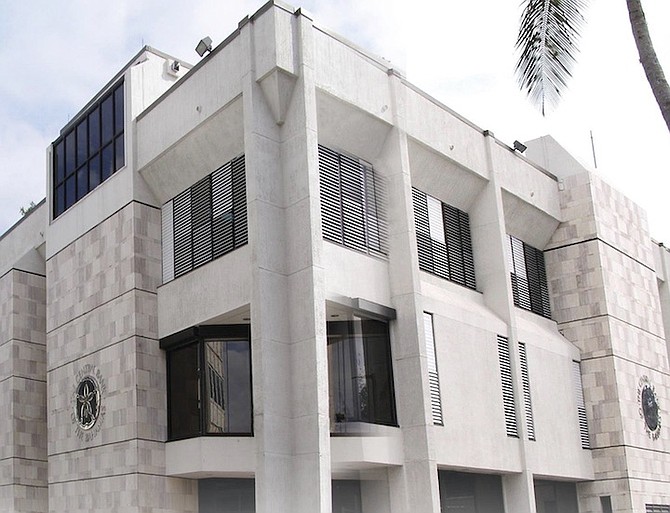By NEIL HARTNELL
Tribune Business Editor
nhartnell@tribunemedia.net
The Bahamas’ foreign currency reserves expanded by almost $169m in May due to a boost from the Government’s external borrowing activities as they closed the month at near-$2.9bn.
The Central Bank, in its May economic developments report, said the expansion in the reserves - which support the country’s one:one fixed exchange rate peg with the US dollar - contrasted with the decline seen during the same month in 2022.
“External reserves expanded by $168.7m to $2.885bn, a reversal from last year’s $62.9m contraction, bolstered by the receipt of proceeds from Government’s external borrowing,” the Central Bank said. “Reflective of this development, the Central Bank’s net foreign currency transactions with the public sector switched to a net inflow of $159m from a net outflow of $150.3m in the preceding year.
“By contrast, the bank’s foreign currency transactions with commercial banks shifted to a net sale of $8.5m from a net intake of $83.8m in 2022. Further, commercial banks recorded a net sale of $6.4m to their customers vis-à- vis a net purchase of $97.9m a year earlier.
“Provisional data on foreign currency sales for current account transactions showed that monthly outflows rose by $120.6m to $812.2m in May relative to the comparable period in 2022. Leading this outturn, payments for ‘other’ current items -primarily credit and debit card financed imports - increased by $101.4m,” the monetary policy regulator added.
“Further, transfer payments advanced by $21.3m, while outflows for non-oil imports grew by $15.2m and for travel related transactions by $3.6m. Conversely, payments for oil imports fell by $15.7m and factor income remittances by $5.3m.”
Turning to domestic credit, the Central Bank said: “Total Bahamian dollar credit reduced by $67.3m during the review month, a reversal from a $141.6m accumulation in the same period last year. Contributing to this development, net claims on the Government decreased by $89.8m, a shift from a $130.3m build-up in 2022.
“Further, the growth in credit to public corporations slowed significantly to just $0.6m from $37.6m in the preceding year. In contrast, private sector credit grew by $22m, a turnaround from a $26.3m decline a year earlier. Specifically, commercial credit rose by $26.2m, vis-à-vis a $10.5m decline in the prior year.
“Likewise, consumer credit increased by $2.7m following an $8.3m fall-off last year. Further, the reduction in mortgages moderated to $6.9m from $7.5m in the preceding year.” As for the foreign currency variety, the Central Bank said: “During the review month, domestic foreign currency credit declined by $17.2m, a switch from a $24.1m build-up in 2022. Underpinning this outturn, private sector credit fell by $9.4m as opposed to a gain of $27.4m in the year prior.
“Specifically, mortgages decreased by $19.7m, extending the $0.8m fall-off in the previous year. Further, the growth in commercial credit moderated to $10.3m from $28.2m in the preceding year. In addition, net claims on the Government reduced by $7.9m, exceeding the $3.3m retrenchment a year earlier. Meanwhile, foreign currency credit to the rest of the public sector registered a flat outturn similar to the previous year.”
Commercial bank loan delinquencies rose slightly in May, with the Central Bank reporting: “Commercial bank credit quality indicators softened during the month of May, concentrated in longer-term delinquencies. Total private sector arrears rose by $1.9m (0.3 percent) to $588.2m, with the accompanying ratio unchanged at 10.9 percent of outstanding private sector claims.
“An analysis by average age of delinquency showed that non-performing loans (NPLs) increased by $6.2m (1.6 percent), to $407.5m, resulting in an uptick in the attendant ratio by nine basis points to 7.5 percent —with a rise in the NPL rate for commercial loans by 59 basis points to 5.2 percent.
“Meanwhile, the NPL rates for mortgage and consumer loans were relatively unchanged at 9.8 percent and 5.8 percent, respectively. In contrast, short-term arrears (31-90 days) decreased by $4.4m (2.4 percent) to $180.7m, with the corresponding ratio narrowing by nine basis points to 3.3 percent.”
The Central Bank added: “A disaggregation by loan type revealed that the uptick in total delinquencies was largely attributed to a rise in consumer arrears, which increased by $4.7m (2.8 percent) to $170.6m, owing mainly to a $5.2m (9.8 percent) growth in the short-term category, which overshadowed the $0.5m (0.4 percent) fall-off in the long-term segment.
“Providing some offset, mortgage arrears declined by $1.8m (0.5 percent) to $362.3m on account of reductions in both the short-term component and non-accruals by $1.1m (0.9 percent) and by $0.7m (0.3 percent), respectively. Similarly, commercial credit delinquencies fell by $1m (1.8 percent) to $55.3m, explained by an $8.5m (63 percent) contraction in short-term arrears, which outstripped the $7.4m (17.3 percent) rise in the non-performing category.
“Banks increased their loan loss provisions by $1m (0.3 percent) to $363.3m in May. However, the ratio of total provisions to NPLs fell by 1.1 percentage point to 89.1 percent, while the ratio for total provisions to arrears narrowed by three basis points 61.8 percent. During the review month, banks also wrote-off an estimated $6.5m in bad loans and recovered approximately $5.1m.”





Comments
ExposedU2C 10 months ago
Only the very incompetent Hartnell can write such a long-winded article about government borrowings with no mention whatsoever of the cost (interest rates) on the borrowings. LMAO
Maximilianotto 10 months ago
The foreign reserves are borrowed at high cost. The net foreign reserves are negative. Otherwise The Bahamas would not receive US$ at rates below 12% per annum meaning considering The Bahamas a high default risk. Venezuela is stronger as they have hard assets. Aragonite and Casinos and web shops aren’t enough and sugarcoating by the administration won’t impress Moody’s. Ultimately the IMF will take over by 2024 latest, year 51 after independence.
Sign in to comment
Or login with:
OpenID